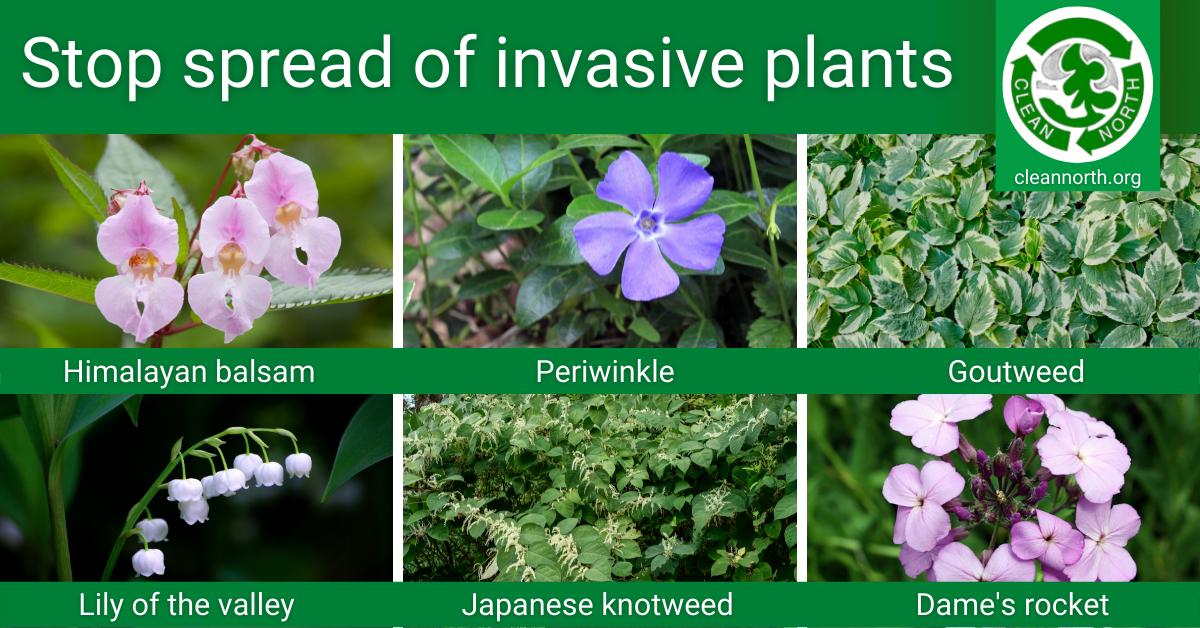
Below we list invasive plant species that may pose a threat to ecosystems, people and the economy in Ontario. Invasive plants that gardeners/property owners in Algoma District are most likely to come across are marked with an asterisk. Other helpful pages:
- Another list on the Credit Valley Conservation Area website
- Ontario Invasive Plant Council invasive plant species lists
- Canadian Coalition for Invasive Plant Regulation invasive species lists page
- Information about why we need a strong legislative/regulatory framework for invasive plants
- Fact sheet for foresters on how to be an ally in the fight against invasive plants
Please be aware that lake, river, and stream ecosystems can also be damaged by invasive plants from aquarium dumping or if your ornamental pond is near a natural waterway and gets flooded.
Sault/Algoma Grow Me Instead Guide | Why/how to remove invasive plants
Growing native plants: Not as simple as you might think
How to grow native plants from seed using winter sowing
Kensington Conservancy/Clean North video on winter sowing
How to collect native plant seed
Invasive spring bulbs
- Scilla/Siberian squill*
- Star of Bethlehem*
Other invasive herbaceous (non-woody) plants
- Baby’s breath
- Bittersweet nightshade*
- Bugleweed*
- Butterfly bush
- Common orange/yellow daylily*
- Common tansy*
- Creeping bellflower*
- Creeping jenny*
- Crown vetch
- Dame’s rocket/wild phlox*
- Dog-strangling vine
- English ivy
- Garlic mustard*
- Giant hogweed
- Goutweed*
- Himalayan balsam*
- Japanese honeysuckle vine*
- Japanese knotweed/bamboo* (before trying to remove this species, read this blog post)
- Japanese stiltgrass
- Kudzu
- Lesser celandine
- Lily of the valley*
- Miscanthus grasses*
- Oriental bittersweet
- Ox-eye daisy*
- Periwinkle*
- Purple loosestrife*
- Reed canary grass*
- Sea buckthorn
- Yellow archangel*
- Yellow flag iris*
- Wild chervil
- Wild parsnip
- Winged euonymous/burning bush*
- Wintercreeper
Invasive aquatic plants
- Eurasian watermilfoil
- European common reed (Phragmites)
- European frog-bit
- Fanwort
- Flowering rush
- Hydrilla
- Narrow leaf and white cattail
- Yellow floating heart
- Water hyacinth
- Water lettuce
- Water soldier
Invasive shrubs/trees
- Autumn olive
- Barberry* (read about link between Japanese barberry and Lyme disease)
- Black locust
- Common/glossy buckthorn*
- European black alder
- False spirea*
- Honeysuckle shrubs, non-native*
- Multiflora rose*
- Norway/amur maples*
- Russian/autumn olives
- Scots pine*
- Siberian pea shrub
- Tamarisk/salt cedar
We’d like to thank the Invasive Species Centre for giving us a microgrant for our Invasive Species Education Project. The Bruce Station Horticultural Society has given us financial support as well. And we have a long list of local partners who offer expertise and cheer us on:
- Sault Naturalists (especially Valerie Walker and Peter Burtch)
- The Kensington Conservancy (especially Carter Dorscht)
- Sault College School of Natural Environment
- SSM Region Conservation Authority
- City of Sault Ste. Marie
- Lake Superior Watershed Conservancy
- Bruce Station, St. Joseph Island, and Sault Ste. Marie horticultural societies
- Seedy Saturday Algoma
- Algoma Master Gardeners
- Johnson Farmers Market
